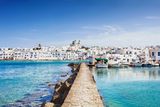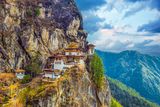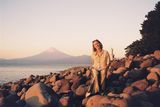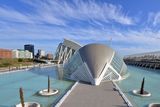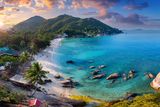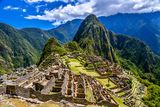Bhutan: Happiness on the roof of the world
Punakha Dzong
Colourful prayer flags flutter in the wind like whispered prayers in remembrance of departed souls. In front of us are the dark green forested mountains and valleys of lush bright green rice fields mirrored with silvery water glinting in the sun. In the far distance are the purple and white-topped peaks of the mighty Himalayas. This is the tiny kingdom of Bhutan.
We have walked far and upwards in the intense heat. We remove our shoes and cover our arms as we step inside the colourful cool interior of a golden temple. We are not Buddhist, but we are welcome. Inside, butter lamps burn as offerings. It is otherworldly. In such pristine peace all is not lost. Indeed, nothing seems lost here.
There is nothing ordinary about Bhutan. Not even unhappiness. It is the last great Himalayan kingdom, a mysterious and magical place where a devout Buddhist culture carefully opened its doors to the world in 1974 and, as a young democracy took determined control of its future in 2008. It would seem vulnerable, a small mountainous country of only 700,000 people, a landlocked mass of crumpled rock surrounded by the giants of Tibet (China) on the one side and India on the other. Some people call it the last Shangri La.
Outside the temple young teenage Buddhist monks - boys dressed in red and yellow robes - are, happily it seems, studying scriptures and in their downtime playing Candy Crush on their smartphones.
Sonam Tshering is the principal of this monastery in Punakha to which we have trekked, and he graciously offers us tea and snacks. We don't need sympathy. Not while we are here. There is nature all around. It is utterly quiet. Clouds lie beneath us. Perspective takes a shift.
The Bhutanese are best known for their happiness. Everything is measured in Gross National Happiness (GNH). The government surveys its people every year with questions related to the state of their happiness.
The people certainly appear easy going and they smile a lot. They don't have a lot, but they do have enough. Of prime importance is that education and healthcare are free for all.
The country is aiming for complete self-sufficiency. Tourism and hydroelectric power, the excess of which is sold to India, are the main source of income.
Depending on the altitude, an abundance of crops are grown. Red rice which forms the staple diet at one level, potatoes at another, oranges and chillies galore. People make their own milk, butter and cheese from their cows and yaks. They weave yak hair into clothes and bags. They grow all sorts of vegetables, organically, naturally, not as an added bonus. They do eat meat on occasion, but never kill or eat their own animals.
Much of their happiness seems to stem from their devout Buddhist learning that all things stem from a clear mind. Even the wild dogs' incessant barking at night don't disturb the people as they are said to be chasing away evil spirits.
The Bhutanese pride themselves on a sustainable approach to tourism in line with their GNH policy. They have opted for a high-end, low volume tourism. Foreign visitors famously pay a minimum tariff of around €200 a day making it seem an expensive destination. But the fee is all-inclusive of accommodation (at 3-star level or supplemented for higher), all food, transport and an official guide. You do not need to go in a group and you can organise your own itinerary. It's a brave move by a country intent on the long-term view.
Having flown dramatically over Mt Everest with Drukair into the valley of Paro at 2,280m we have six days in which to cover Western Bhutan. It is quite enough time.
The car journey isn't hard if you don't mind driving along winding mountain roads - most, but not all of them, recently widened and upgraded, with sheer drops and magnificent views. We have a capable driver called Gangla (who, incidentally, has two wives, as polygamy is acceptable in Bhutan) and a warm, attentive guide called Drakpa Dorji. Both are caring for us courtesy of Blue Poppy Tours, one of the oldest and one of the best agents operating in Bhutan with an office in London.
I am surprised by how fertile and pristine the landscape is, forested and far greener than I imagined for a mountain-scape, with sweeping valleys and snow-topped peaks. By law, 60pc of the country must remain forested for future generations. At the moment it is 70pc.
Our first stop is Thimphu, the capital of Bhutan, and an hour's drive from Paro airport. Here there are no traffic lights, no fast food joints, no advertising (apart from posters of the king), no smoking (despite the fact that marijuana grows wild), no robbery, no begging, no buildings over six storeys and all built to a strict code of the beautiful traditional Bhutanese-style architecture. Everyone, including schoolchildren, wears the colourful woven traditional dress, the Gho for the men and the Kira for the woman.
One of the highlights of Thimphu is visiting the School of Traditional Arts. Bhutan has, amazingly, retained its 13 indigenous arts and crafts including painting, sculpture, embroidery, metalwork, and woodturning, and they are all still actively and seriously taught to students over a four to six-year period.
In Thimphu we spent the first two nights at the Norkhil Boutique. It's a beautifully designed locally owned new hotel with large modern rooms overlooking the mountains, ever pleasant staff, and a fantastic Indian chef in the restaurant. Owner Chuni Dorji explains that the king gave her father the land as a gift for his military service and she spent 10 years persuading him to let her build a hotel, which was designed by her architect husband.
Our second two-day stop is the valley of Punakha, three hours' drive from Thimphu. On our way we ascend to 3,050m via the Dochu La pass where 108 stupas (Buddhist meditation/memorial shrines) overlook the most perfect view of the vast blue tinted Eastern Himalaya range.
In the afternoon we walk across the terraced rice fields to Chimi Lhakhang (Temple of Fertility) built in the 15th Century by the Divine Madman who was said to bring Buddhism to Bhutan - and to use his giant penis to clobber the demons into submission. For this reason, phalluses of all shapes and sizes greet us in the village - freestanding wooden varieties and painted on the walls of every house to ward off evil. Quite.
Punakha Dzong - the largest and most beautiful fortress on the river - is shared by the monks and the government administration. Our guide recounts Buddhist history stories of flying tigers, dragons and demons, tales of magic and myth told in real time. He doesn't differentiate between the natural and the supernatural. It's a living Buddhist history and a kind of magical thinking that is quite breathtaking.
In Punakha we are staying at Amankora, a beautiful modern eight-room lodge designed by the late well-known architect Kerry Hill. The rooms are built around an old farmhouse once inhabited by the abbess and later the queen mother.
Amankora (meaning circular journey) is part of the Aman luxury chain with five lodges located all over Bhutan. The novel idea is that you travel from one to the other on your journey through Bhutan.
We spend the next two nights at Amankora Paro, identical to Punakha in its minimalist design of wood and natural fabric interiors but bigger with 24 rooms set amid a forest of blue pine.
Paro is our final destination and the main reason to stop here is the famous Tiger's Nest Monastery.
It is an important pilgrimage site for the Bhutanese and tourist alike. A breathless two-hour hike up 900m to the unlikeliest temple in the world that hugs the side of the mountain like a nest, it doesn't disappoint.
There are so many reasons to visit this unique and special country.
If you are a hiker it is pure paradise - endless trails that can take hours or days in which you can camp out in search of the rare blue poppy emblematic of Bhutan. Or catch the rhododendron in bloom in spring or arrive in autumn for the local music and dance festivals.
And if, like me, hiking isn't your thing, there is enough scenic beauty and plenty of cultural attractions to make up for lost time.
Not to mention a glimpse of eternal happiness.
Punakha Dzong
Punakha Dzong is the most beautiful Buddhist monastery in Bhutan. This dzong situated in the Punakha valley and surrounded by jacaranda trees was the second to be built in Bhutan and it served as the capital and seat of government until the 1950s.
Get there
÷ Blue Poppy Tours & Treks — a specialist Bhutanese tour operator with offices in London and Bhutan. www.bluepoppybhutan.com; choki@bluepoppybhutan.com; +44 207 609 2029
÷ Flights to Paro are via Bangkok or Delhi. Druk Air: www.drukair.com.bt
Bhutan Airlines: www.bhutanairlines.com.bt
÷ Norkhil Boutique Hotel & Spa
Thimphu. www.norkhil.com; reservation@norkhil.com; +975 2 330356/57/58
÷ Packages: Seven days/six night tours for two people from €1,400 per person include all government taxes, personal guide and driver, three-star accommodation on a full-board basis and all travel and sightseeing arrangements, including entrance fees, permits and visas.
Flights charged separately.
÷ Supplement for Norkhil: From €75 per room per night, bed and breakfast only. Rates at Amankora start from €1,200 per night and include full board and airport transfers.
Bookings can be made directly online at www.aman.com or via +975 2 331 333.
This feature originally appeared in The Sunday Independent.
Join the Irish Independent WhatsApp channel
Stay up to date with all the latest news
